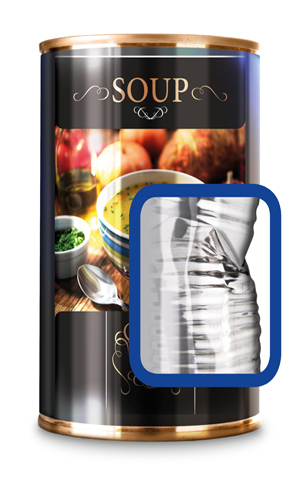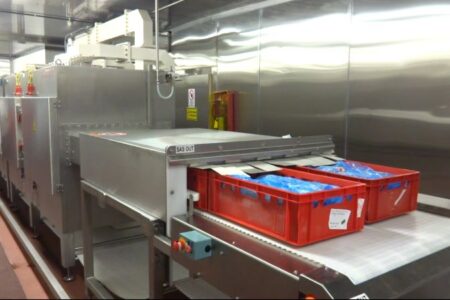Ensuring conformity of packaged food

Daniela Verhaeg explains how food manufacturers can integrate advanced product inspection technologies into their production processes to ensure consistency and repeatability at all times.
Conformity comes in many guises. It can entail making sure that both product and package are free of defects and perfectly presented at the point of consumption. This may be as simple as ensuring that the label is always in exactly the same position, or as complex as checking that all the chocolates within a box having the same amount of topping.
The consequences of food non-conformity can be severe, especially if it is due to foreign body contamination. For an individual, it may have serious health implications, or even prove fatal. For the businesses concerned, it may result in a product recall, financial penalty, criminal prosecution or even closure.
Advanced product inspection technology can perform multiple integrity checks simultaneously to prove product conformity. Furthermore, combining different technologies in a single machine can deliver productivity and efficiency savings.
Contamination aspects
A Hazard Analysis Critical Control Point (HACCP) evaluation will identify the potential types of contaminants that could affect product conformity. By considering the different product types and packaging materials involved, the evaluation will determine how and where a contaminant is likely to enter the process.
Metal detection technology provides the best means of detecting ferrous, non-ferrous (brass and aluminium) and stainless steel metal contaminants. Until recently, it was not possible to detect small unwanted metal items using a metal detector when products were packaged in metallised film. However, the latest advancements in metal detection systems, which use multi simultaneous frequency and product signal suppression technology, now also deliver high sensitivity in these types of applications.
X-ray inspection systems can inspect all packaging types for unwanted physical contaminants, such as calcified bone, glass shards, metal fragments, mineral stone, dense plastic and rubber compounds. They detect foreign bodies, irrespective of their shape or location within the product, at fast production speeds. As x-ray technology examines the overall product, several additional inspection checks can be performed simultaneously to ensure food safety and product conformity.
Product and packaging integrity
X-ray inspection technology has the capability to inspect for missing items contained within the primary or secondary package. In the primary package, this can include counting sausages to ensure the correct amount are contained within one pack, checking for promotional giveaways in cereal packets and identifying the presence of a plastic measuring scoop in infant formula containers. Within secondary packaging, x-ray systems are installed at the end of the line, before dispatch, to check that each box contains the correct number of primary packs. An x-ray image of each pack, even within multipacks, will reveal any underfilled or overfilled products.
X-ray gross mass measurement checks the overall weight of each pack and will reject any non-conforming products outside of a specified weight range. Zoned mass measurement is best suited when the mass of individual items inside the pack must be examined, such as each compartment of a ready meal. This is important, as an underfill in one compartment could be compensated by an overfill in another compartment.
In-line checkweighers ensure that each package is accurately weighed, in real time, based on the predetermined content weight of each compartment. This enables the manufacturer to investigate filling deviations within the processing stage. As an option, the checkweigher can be set up to control upstream filling machines. If the checkweigher detects any unacceptable deviation, it will reject non-conforming products and can adjust the connected filling machine automatically, thus avoiding costly giveaway.
Seal integrity
Spillage and spoilage during transportation and storage are another significant threat to product conformity, so it is essential that the closure is properly aligned and fitted. Product trapped underneath the seal can lead to a weakening of the closure, a risk to the freshness of the product and to actual contamination.
X-ray technology detects dense product between the outer and inner edges of the seal, while vision systems check sealed edges for excess food. Both systems successfully remove all non-conforming products from the production line for further investigation. Tamper-evident seals are becoming more popular to give consumers confidence of product integrity. They are a valuable tool in the fight against food fraud and are commonly used on baby food jars, for example. For additional security, a serialisation number can be printed on the tamper seal. Advanced vision technology enables the inspection of tamper-evident seals in real time to guarantee that the product was securely sealed when leaving the production facility and can also verify the individual serialisation numbers to protect consumers against security breaches further on in the supply chain.
Label accuracy
Vision technology enables manufacturers to inspect the positioning and content of labels at high production speeds and verifies that the right label is attributed to the correct package. It inspects all label information to ensure consumer safety and compliance with labelling regulations, irrespective of variable print applications. Checks for the presence and quality of the date and lot information minimise the risk of expired product entering the marketplace and are vital in the event of a product recall. Recent innovations even verify the accuracy and quality of inkjet dot printing and provide an additional level of quality control. The latest innovations in product inspection technology enable x-ray systems to simultaneously check for dents or damages to the package, while advanced vision inspection can verify if branding guidelines have been upheld and that all relevant information regarding ingredients is correctly displayed.
Connected conformity
The paramount requirement for any successful conformity initiative is access to quality data. Connected product inspection systems enable manufacturers to access food safety management information in real time. To centrally control and monitor all food safety activities and production data, innovative inspection data management software provides seamless integration of product inspection devices. This allows for constant monitoring of all conformity relevant data and ensures quality assurance processes are documented in a more streamlined, accessible and efficient way. This data can be centrally stored and made available for statistical analysis and production line control.
Advanced connectivity options enable remote access; conformity parameters relating to product line changeovers can be quickly assigned, thereby upholding production conformity with minimal downtime. Further advancements are encouraging adoption of Industry 4.0 principles in the food sector to facilitate faster, more informed decision making when a labelling or contaminant issue has occurred, automating data exchanges with greater transparency throughout the food industry supply chain.
Consistent quality
Combining advanced product inspection technologies, robust food safety management programmes and quality assurance processes will enable manufacturers and brand owners to consistently produce conforming packaged food. In maintaining quality and consistency, they will secure a strong reputation in the industry as an advocate for food safety and, in the event of a product recall, will be able to quickly act and regain their leadership position in the packaged food marketplace.
The importance of selecting competent suppliers and service partners to implement and uphold class leading product conformity cannot be stressed enough. Suppliers and service partners must have up to the minute regulatory knowledge, proven understanding of the latest technologies and must have the knowhow to integrate these new systems into existing production facilities.
To learn more about how to ensure conformity of packaged food, download the latest whitepaper from Mettler-Toledo, Ensuring Conformity of Packaged Food.
—
Author
Daniela Verhaeg is product inspection specialist at Mettler-Toledo.



